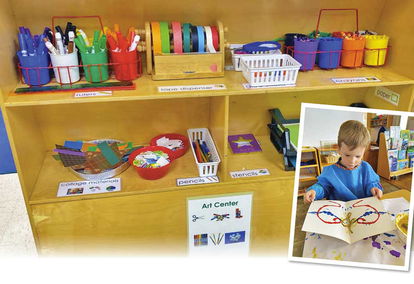Learn More About the Art Interest Area

“There is no must in art because art is free.”
—Wassily Kandinsky
Often credited as one of the early creators of abstract art, it makes sense that Mr. Kandinsky would feel this way. A quick look at his body of work and it is clear he did not feel constrained by formality or realistic subject matter. His art focused on shapes and color, lines, and emotions. He felt free to create what he wanted, not what was expected.
As we establish art interest areas in our Mission Friends classrooms, we would do well to remember Mr. Kandinsky’s words. While we of course provide guidelines and connections to our missions areas, missionaries, and Christian concept areas, we want our preschoolers to feel free and safe to create art that is unique to them—art that reflects what they’re learning, what they’re thinking, and how they’re feeling. So, how do we do that? How do we stay missions focused while also encouraging creativity and autonomy?
For starters, we focus on process, not product. The goal of the art interest area is not to produce a class set of identical creations. The goal is to provide a task suggestion that connects to our outcome and to let our preschoolers take it from there. We’re not there to correct their work or suggest another way to do it. Our role is to observe, ask questions, and celebrate the unique ways they interpret the task and create something special. When we focus on the process and let their work develop organically, our preschoolers feel free to try new things without second-guessing their abilities.
In addition to focusing on process over product, it is important to provide a variety of materials. If our art interest areas include only paper and crayons each week, there is a good chance preschoolers will lose interest. When we provide choices (maybe crayons and colored pencils) or when we include new materials (watercolor paint or scissors and glue), we keep the art interest area fresh. This encourages preschoolers to visit again and again.
Along with variety, we want to present materials in an organized and accessible way. This may mean using a separate bin for each art supply being offered. This may look like labeling containers in an age-appropriate way. If it works in your space, it may look like placing the supplies being offered on a shelf or table preschoolers can access without assistance. This provides a way for preschoolers to pick and choose what they want to use. The more independent preschoolers can be in selecting and using art supplies, the more we encourage creativity and autonomy.
The art interest area is an important part of the Mission Friends classroom. In addition to reinforcing the learning outcomes, art experiences support social and emotional development by allowing preschoolers to relax and express how they feel. Art supports physical development by strengthening fine motor skills and it even bolsters cognitive development by giving preschoolers the opportunity to plan and problem solve.
As adults who often think about the right and wrong ways to accomplish tasks, the freedom of art can be overwhelming. But for preschoolers, art is a beautiful means of expression. As leaders, we can set preschoolers up for artistic success.
by Bethany Davenport